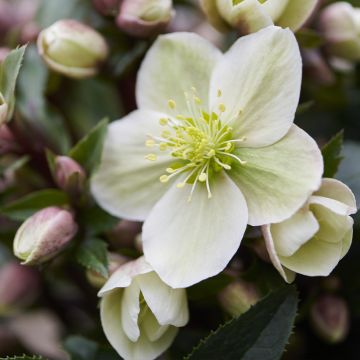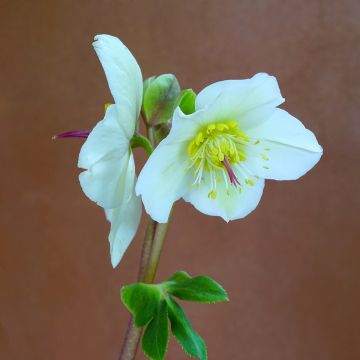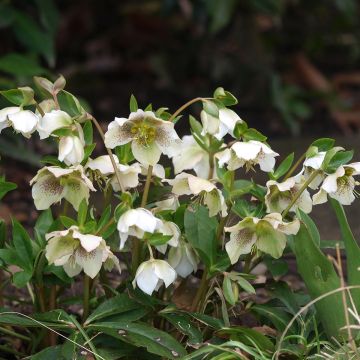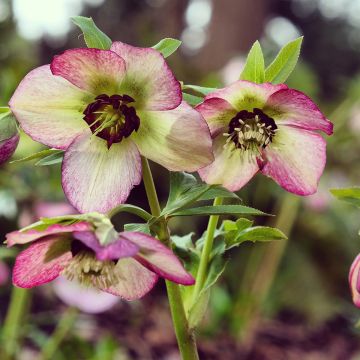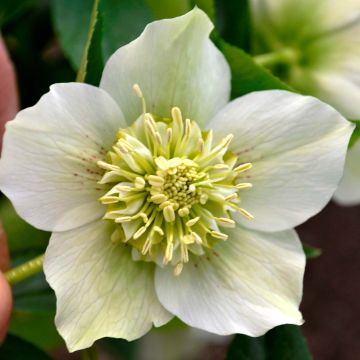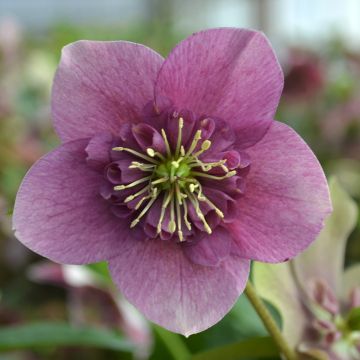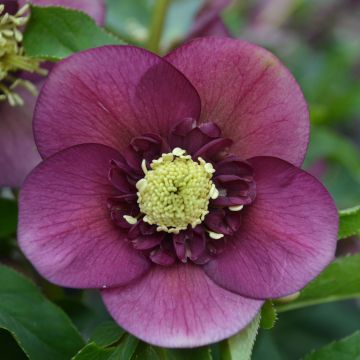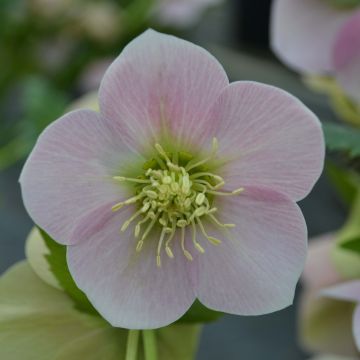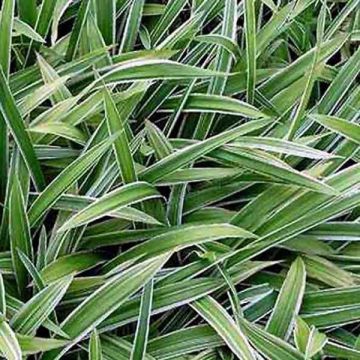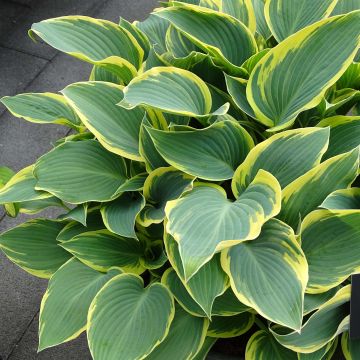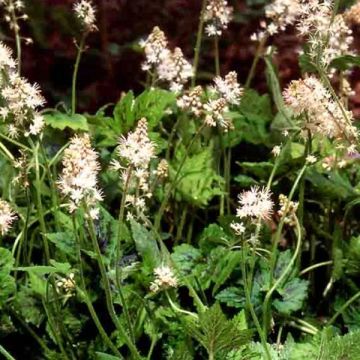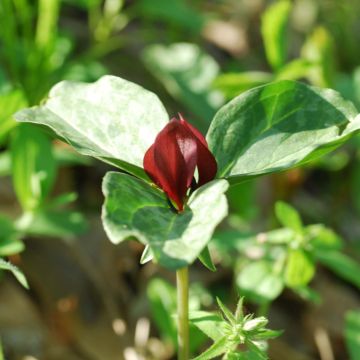

Hellébore ViV® Gianina - Helleborus orientalis
Helleborus hybridus ViV Gianina
Helleborus x hybridus ViV® Gianina
Lenten Rose, Oriental Hellebore
Why not try an alternative variety in stock?
View all →This plant carries a 12 months recovery warranty
More information
We guarantee the quality of our plants for a full growing cycle, and will replace at our expense any plant that fails to recover under normal climatic and planting conditions.
From €5.90 for pickup delivery and €6.90 for home delivery
Express home delivery from €8.90.
Does this plant fit my garden?
Set up your Plantfit profile →
Description
Oriental Hellebore ViV Gianina is a recent variety with particularly early flowering. Blooming for several weeks from September, this Lenten Rose produces large double, open white flowers with a yellow stamen centre. This evergreen perennial with dark green leaves forms a fairly tall tuft, decorative in all seasons. Robust and very hardy, it is easy to grow in all regions. Plant it in light shade or even denser shade to protect it from the sun's intense rays, with other perennials to create a varied and colourful bed. It is a variety derived from in vitro culture, disease-free, more floriferous and more colourful than those from traditional propagation methods.
The ViV® Hellebores are varieties derived from in-vitro propagation. Unlike varieties derived from seed propagation, Hellebores produced by in-vitro guarantee flowering that is identical to the variety from which they are derived. They have the same genetic characteristics as the mother plant, are more vigorous and develop uniformly.
Hellebore ViV Gianina belongs to the Ranunculaceae family, which includes about sixty genera and around 2500 species, mostly herbaceous. The species Helleborus orientalis is native to Greece, Turkey, and the central and eastern Caucasus. It is a perennial plant that readily hybridizes with other species to produce many hybrids with varied colours and forms. Variety names ar rarely given to these hybrids they are distinguished by their shape and colour. The Oriental Hellebore is a hardy plant that tolerates temperatures as low as -15°C, naturally growing in forests, thickets, and clearings up to an altitude of 2,000 m (2,187 yards).
Part of a wide range of hybrids selected for their compactness and abundant flowering, this variety has superior growth as it forms a tuft that can only reach 55 cm (22in) in height, with a width of about forty. Its vegetation consists of palmate, slightly toothed, dark green and shiny basal leaves. These are evergreen leaves which live for only 8 months and are regularly replaced by new leaves. Opening widely in all directions, they give Gianina a somewhat airy appearance, quite different from the compact and compressed habits of many other varieties in this group.
Gianina also flowers earlier than others, as early as September for many weeks until October and even later. The flowers are almost immaculately white, with only the base of the petals being slightly greenish, from where yellow stamens emerge in the centre. These are quite large flowers, with a row of outer petals that are well open and spread out and inner petals that are more wavy. These flowers are carried by fairly long peduncles that stand out distinctly from the mass of evergreen foliage, making them clearly visible with their size and light colour. They are inclined downwards, giving them a certain casual grace and allowing water to slide off like an umbrella protecting the heart, which would otherwise rot. Hellebore does not like to be moved once established, with young plants sometimes taking time to flower. So be sure to choose their location carefully when planting.
This Gianina Hellebore is a very beautiful perennial for autumn, which you can combine with other seasonal flowers. It will go well with small autumn Asters, such as the Aster dumosus Bahamas, which forms a short and compact tuft covered with bright pink star-shaped flowers from August and tolerates partial shade. To give a wild touch to a tree border, plant Eupatorium coelestinum behind Gianina, a plume-like blue-flowered Eupatorium that will harmonize beautifully with the pure white of our Oriental Hellebore. To extend the flowering season, mix it with other varieties of Winter Hellebores, and Cyclamen coum, which is also comfortable in woodland situations and will reward you with its beautiful pink flowers from January onwards.
Report an error about the product description
Flowering
Foliage
Plant habit
Safety measures
Botanical data
Helleborus
x hybridus
ViV® Gianina
Ranunculaceae
Lenten Rose, Oriental Hellebore
Cultivar or hybrid
ingestion
Cette plante est toxique si elle est ingérée volontairement ou involontairement.
Ne la plantez pas là où de jeunes enfants peuvent évoluer, et lavez-vous les mains après l'avoir manipulée.
Pensez à conserver l'étiquette de la plante, à la photographier ou à noter son nom, afin de faciliter le travail des professionnels de santé.
Davantage d'informations sur https://plantes-risque.info
Other Oriental Hellebore
Planting and care
Oriental Hellebore Gianina grows in any neutral to moderately chalky soil, or even slightly acidic, rich, light or clayey, in partial or light shade, sheltered from cold and dominant winds. Avoid direct sunlight during the hottest hours in the south. This perennial should be planted from early autumn to spring. It thrives in deeply worked soil mixed with organic matter. To feed, use bone meal or another organic fertilizer. Water well after planting and add a layer of mulch 2 to 5 cm (1 to 2in) thick. Regularly remove faded leaves to improve flowering. Ensure a planting distance of 35 to 45 cm (14 to 18in) between each plant to encourage their development. Hellebore does not tolerate stagnant water, as it may cause rotting.
The roots should not completely dry out in summer. Hellebores can be affected by a disease transmitted by aphids, known as black spot. Remove any stained leaves when the flower buds appear. Remove faded flowers after seeding. They can also suffer from grey rot or collar rot due to poor growing conditions, in excessively moist situations.
On a balcony or terrace, plant this perennial in a pot 4 to 5 times larger than its size, as it needs space to develop its root system. This Hellebore can withstand temperatures down to -15°C or even lower, allowing it to adapt to almost all regions.
Planting period
Intended location
Care
This item has not been reviewed yet - be the first to leave a review about it.
Shade-loving perennials
Haven't found what you were looking for?
Hardiness is the lowest winter temperature a plant can endure without suffering serious damage or even dying. However, hardiness is affected by location (a sheltered area, such as a patio), protection (winter cover) and soil type (hardiness is improved by well-drained soil).

Photo Sharing Terms & Conditions
In order to encourage gardeners to interact and share their experiences, Promesse de fleurs offers various media enabling content to be uploaded onto its Site - in particular via the ‘Photo sharing’ module.
The User agrees to refrain from:
- Posting any content that is illegal, prejudicial, insulting, racist, inciteful to hatred, revisionist, contrary to public decency, that infringes on privacy or on the privacy rights of third parties, in particular the publicity rights of persons and goods, intellectual property rights, or the right to privacy.
- Submitting content on behalf of a third party;
- Impersonate the identity of a third party and/or publish any personal information about a third party;
In general, the User undertakes to refrain from any unethical behaviour.
All Content (in particular text, comments, files, images, photos, videos, creative works, etc.), which may be subject to property or intellectual property rights, image or other private rights, shall remain the property of the User, subject to the limited rights granted by the terms of the licence granted by Promesse de fleurs as stated below. Users are at liberty to publish or not to publish such Content on the Site, notably via the ‘Photo Sharing’ facility, and accept that this Content shall be made public and freely accessible, notably on the Internet.
Users further acknowledge, undertake to have ,and guarantee that they hold all necessary rights and permissions to publish such material on the Site, in particular with regard to the legislation in force pertaining to any privacy, property, intellectual property, image, or contractual rights, or rights of any other nature. By publishing such Content on the Site, Users acknowledge accepting full liability as publishers of the Content within the meaning of the law, and grant Promesse de fleurs, free of charge, an inclusive, worldwide licence for the said Content for the entire duration of its publication, including all reproduction, representation, up/downloading, displaying, performing, transmission, and storage rights.
Users also grant permission for their name to be linked to the Content and accept that this link may not always be made available.
By engaging in posting material, Users consent to their Content becoming automatically accessible on the Internet, in particular on other sites and/or blogs and/or web pages of the Promesse de fleurs site, including in particular social pages and the Promesse de fleurs catalogue.
Users may secure the removal of entrusted content free of charge by issuing a simple request via our contact form.
The flowering period indicated on our website applies to countries and regions located in USDA zone 8 (France, the United Kingdom, Ireland, the Netherlands, etc.)
It will vary according to where you live:
- In zones 9 to 10 (Italy, Spain, Greece, etc.), flowering will occur about 2 to 4 weeks earlier.
- In zones 6 to 7 (Germany, Poland, Slovenia, and lower mountainous regions), flowering will be delayed by 2 to 3 weeks.
- In zone 5 (Central Europe, Scandinavia), blooming will be delayed by 3 to 5 weeks.
In temperate climates, pruning of spring-flowering shrubs (forsythia, spireas, etc.) should be done just after flowering.
Pruning of summer-flowering shrubs (Indian Lilac, Perovskia, etc.) can be done in winter or spring.
In cold regions as well as with frost-sensitive plants, avoid pruning too early when severe frosts may still occur.
The planting period indicated on our website applies to countries and regions located in USDA zone 8 (France, United Kingdom, Ireland, Netherlands).
It will vary according to where you live:
- In Mediterranean zones (Marseille, Madrid, Milan, etc.), autumn and winter are the best planting periods.
- In continental zones (Strasbourg, Munich, Vienna, etc.), delay planting by 2 to 3 weeks in spring and bring it forward by 2 to 4 weeks in autumn.
- In mountainous regions (the Alps, Pyrenees, Carpathians, etc.), it is best to plant in late spring (May-June) or late summer (August-September).
The harvesting period indicated on our website applies to countries and regions in USDA zone 8 (France, England, Ireland, the Netherlands).
In colder areas (Scandinavia, Poland, Austria...) fruit and vegetable harvests are likely to be delayed by 3-4 weeks.
In warmer areas (Italy, Spain, Greece, etc.), harvesting will probably take place earlier, depending on weather conditions.
The sowing periods indicated on our website apply to countries and regions within USDA Zone 8 (France, UK, Ireland, Netherlands).
In colder areas (Scandinavia, Poland, Austria...), delay any outdoor sowing by 3-4 weeks, or sow under glass.
In warmer climes (Italy, Spain, Greece, etc.), bring outdoor sowing forward by a few weeks.

































